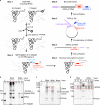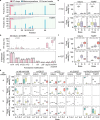Genome-wide profiling of tRNA modifications by Induro-tRNAseq reveals coordinated changes
- PMID: 39865096
- PMCID: PMC11770116
- DOI: 10.1038/s41467-025-56348-1
Genome-wide profiling of tRNA modifications by Induro-tRNAseq reveals coordinated changes
Abstract
While all native tRNAs undergo extensive post-transcriptional modifications as a mechanism to regulate gene expression, mapping these modifications remains challenging. The critical barrier is the difficulty of readthrough of modifications by reverse transcriptases (RTs). Here we use Induro-a new group-II intron-encoded RT-to map and quantify genome-wide tRNA modifications in Induro-tRNAseq. We show that Induro progressively increases readthrough over time by selectively overcoming RT stops without altering the misincorporation frequency. In a parallel analysis of Induro vs. a related RT, we provide comparative datasets to facilitate the prediction of each modification. We assess tRNA modifications across five human cell lines and three mouse tissues and show that, while the landscape of modifications is highly variable throughout the tRNA sequence framework, it is stabilized for modifications that are required for reading of the genetic code. The coordinated changes have fundamental importance for development of tRNA modifications in protein homeostasis.
© 2025. The Author(s).
Conflict of interest statement
Competing interests: Y.N., H.G., H.M, S.M, J.L., N.S.L., J.A.P., R.K, B.D.G., and Y.M.H. declare no competing interests. Z.S., K.K., E.Y., S.G., and N.N. are employees of New England Biolabs, Inc., where Z.S. performed data analysis, K.K. and S.G. performed Illumina sequencing of tRNAseq libraries, and E.Y. and N.N. provided discussion. New England Biolabs is a manufacturer and vendor of molecular biology reagents, including Induro, Rnl2, T4 PNK, restriction enzymes, and several buffers used in this study. These authors declare no competing interests. The affiliation of Z.S., K.K., E.Y., S.G., and N.N. with New England Biolabs does not affect these authors’ impartiality, adherence to journal standards and policies, or objective data presentation, analysis, and interpretation.
Figures







References
-
- Suzuki, T. The expanding world of tRNA modifications and their disease relevance. Nat. Rev. Mol. Cell Biol.22, 375–392 (2021). - PubMed
MeSH terms
Substances
Grants and funding
LinkOut - more resources
Full Text Sources

